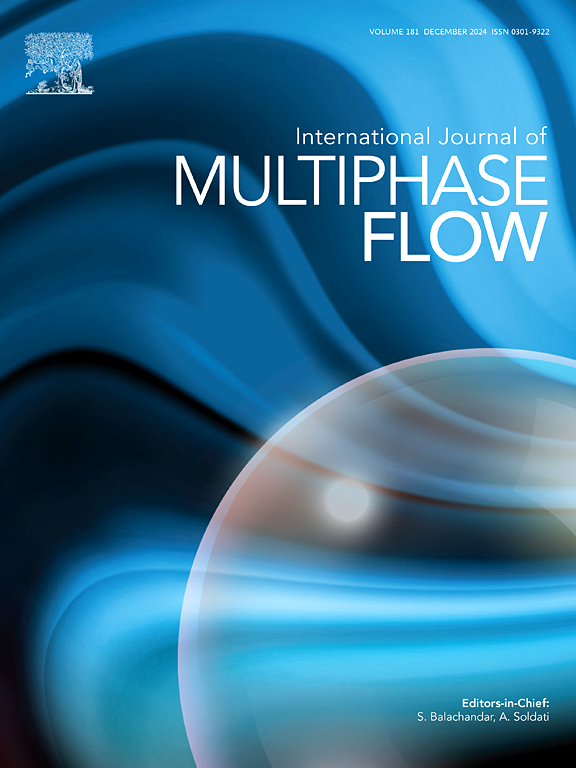Two-phase flows downstream, upstream and within Plate Heat Exchangers
IF 3.6
2区 工程技术
Q1 MECHANICS
International Journal of Multiphase Flow
Pub Date : 2024-11-14
DOI:10.1016/j.ijmultiphaseflow.2024.105062
引用次数: 0
Abstract
Air-water flows were assessed within Plate Heat Exchangers (PHE) with the aid of fast camera imaging. Tests occurred in transparent setups with three chevron angle arrangements (30o/30o, 30o/60o and 60o/60o), representative of low, in-between and high pressure drop channels. Evaluation upstream the PHE inlet happened with Electrical Capacitance Tomography. Three patterns were tested: bubbly, slug and stratified. The effects of flow direction, superficial fluid velocities, two-phase pattern, and chevron angle arrangement on air-water distributions were assessed. The PHE channel outlet is characterized by intense flow recirculation. Bubble entrapment occurs in the core of the recirculation zones. Energy dissipation processes along the PHE channel flow affect the inlet gaseous content, intensifying the mixing process of air and water phases, particularly at flow distribution areas owing to the occurrence of flow acceleration and deceleration. Bubble distribution is wide since the break-up process is rather heterogeneous. Prediction of the maximum bubble diameter was obtained with a modification to Hinze's model. Coalescence can occur with small liquid superficial velocities. At the exit manifold, the recirculation zones affect the two-phase pipe flow. In addition to swirling decay, two-phase flow features and gravitational forces need to be accounted to determine the necessary pipe length to attain stationary process.

板式换热器下游、上游和内部的两相流
借助快速相机成像技术,对板式热交换器(PHE)内的空气-水流量进行了评估。测试在透明设置中进行,有三种雪佛龙角排列(30o/30o、30o/60o 和 60o/60o),分别代表低压降、中间压降和高压降通道。使用电容断层扫描对 PHE 上游入口进行评估。测试了三种模式:气泡、蛞蝓和分层。评估了流向、表层流体速度、两相模式和雪佛龙角排列对空气-水分布的影响。PHE 通道出口的特点是强烈的水流再循环。气泡夹带发生在再循环区的核心位置。PHE 通道流动的能量耗散过程影响了入口气体含量,加剧了气相和水相的混合过程,尤其是在流动加速和减速的流动分布区域。气泡分布很广,因为破裂过程相当不均匀。通过修改 Hinze 模型,可以预测最大气泡直径。在液体表面速度较小的情况下也会发生凝聚。在出口歧管处,再循环区会影响两相管道流动。除了漩涡衰减外,还需要考虑两相流特征和重力,以确定达到静止过程所需的管道长度。
本文章由计算机程序翻译,如有差异,请以英文原文为准。
求助全文
约1分钟内获得全文
求助全文
来源期刊
CiteScore
7.30
自引率
10.50%
发文量
244
审稿时长
4 months
期刊介绍:
The International Journal of Multiphase Flow publishes analytical, numerical and experimental articles of lasting interest. The scope of the journal includes all aspects of mass, momentum and energy exchange phenomena among different phases such as occur in disperse flows, gas–liquid and liquid–liquid flows, flows in porous media, boiling, granular flows and others.
The journal publishes full papers, brief communications and conference announcements.

 求助内容:
求助内容: 应助结果提醒方式:
应助结果提醒方式:


